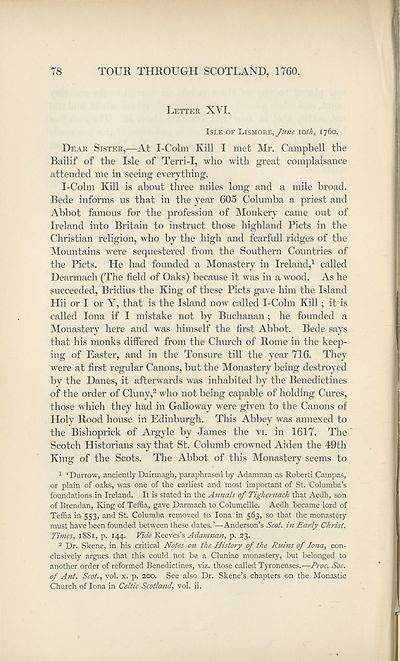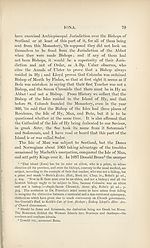Series 1 > Tours in Scotland 1747, 1750, 1760
(165) Page 78
Download files
Complete book:
Individual page:
Thumbnail gallery: Grid view | List view

78
TOUR THROUGH SCOTLAND, 1760.
Letter XVI.
Isle of Lismore,/mm« \oth, 1760.
Dear Sister,—At I-Colm Kill I met Mr. Campbell the
Bailif of the Isle of Terri-I, who with great complaisance
attended me in seeing everything.
I-Colm Kill is about three miles long and a mile broad.
Bede informs us that in the year 605 Columba a priest and
Abbot famous for the profession of Monkery came out of
Ireland into Britain to instruct those highland Piets in the
Christian religion, who by the high and fearfull ridges of the
Mountains were sequestered from the Southern Countries of
the Piets. He had founded a Monastery in Ireland,1 called
Dearmach (The field of Oaks) because it was in a wood. As he
succeeded, Bridius the King of these Piets gave him the Island
Hii or I or Y, that is the Island now called I-Colm Kill; it is
called Iona if I mistake not by Buchanan ; he founded a
Monastery here and was himself the first Abbot. Bede says
that his monks differed from the Church of Rome in the keep¬
ing of Easter, and in the Tonsure till the year 716. They
were at first regular Canons, but the Monastery being destroyed
by the Danes, it afterwards was inhabited by the Benedictines
of the order of Cluny,2 who not being capable of holding Cures,
those which they had in Galloway were given to the Canons of
Holy Rood house in Edinburgh. This Abbey was annexed to
the Bishoprick of Argyle by James the vi. in 1617. The
Scotch Historians say that St. Columb crowned Aiden the 49th
King of the Scots. The Abbot of this Monastery seems to
1 ‘Durrow, anciently Dairmagh, paraphrased by Adamnan as Roberti Campas,
or plain of oaks, was one of the earliest and most important of St. Columba’s
foundations in Ireland. It is stated in the Annals of Tighernach that Aedh, son
of Brendan, King of Teffia, gave Darmach to Columcille. Aedh became lord of
Teffia in 553, and St. Columba removed to Iona in 563, so that the monastery
must have been founded between these dates. ’—Anderson’s Sool. in Early Christ.
Times, 1881, p. 144. Vide Reeves’s Adamtian, p. 23.
2 Dr. Skene, in his critical Notes on the History of the Ruins of Iona, con¬
clusively argues that this could not be a Cluniac monastery, but belonged to
another order of reformed Benedictines, viz. those called Tyronenses.—Proc. Soc.
of Ant. Scot., vol. x. p. 200. See also Dr. Skene’s chapters on the Monastic
Church of Iona in Celtic Scotland, vol. ii.
TOUR THROUGH SCOTLAND, 1760.
Letter XVI.
Isle of Lismore,/mm« \oth, 1760.
Dear Sister,—At I-Colm Kill I met Mr. Campbell the
Bailif of the Isle of Terri-I, who with great complaisance
attended me in seeing everything.
I-Colm Kill is about three miles long and a mile broad.
Bede informs us that in the year 605 Columba a priest and
Abbot famous for the profession of Monkery came out of
Ireland into Britain to instruct those highland Piets in the
Christian religion, who by the high and fearfull ridges of the
Mountains were sequestered from the Southern Countries of
the Piets. He had founded a Monastery in Ireland,1 called
Dearmach (The field of Oaks) because it was in a wood. As he
succeeded, Bridius the King of these Piets gave him the Island
Hii or I or Y, that is the Island now called I-Colm Kill; it is
called Iona if I mistake not by Buchanan ; he founded a
Monastery here and was himself the first Abbot. Bede says
that his monks differed from the Church of Rome in the keep¬
ing of Easter, and in the Tonsure till the year 716. They
were at first regular Canons, but the Monastery being destroyed
by the Danes, it afterwards was inhabited by the Benedictines
of the order of Cluny,2 who not being capable of holding Cures,
those which they had in Galloway were given to the Canons of
Holy Rood house in Edinburgh. This Abbey was annexed to
the Bishoprick of Argyle by James the vi. in 1617. The
Scotch Historians say that St. Columb crowned Aiden the 49th
King of the Scots. The Abbot of this Monastery seems to
1 ‘Durrow, anciently Dairmagh, paraphrased by Adamnan as Roberti Campas,
or plain of oaks, was one of the earliest and most important of St. Columba’s
foundations in Ireland. It is stated in the Annals of Tighernach that Aedh, son
of Brendan, King of Teffia, gave Darmach to Columcille. Aedh became lord of
Teffia in 553, and St. Columba removed to Iona in 563, so that the monastery
must have been founded between these dates. ’—Anderson’s Sool. in Early Christ.
Times, 1881, p. 144. Vide Reeves’s Adamtian, p. 23.
2 Dr. Skene, in his critical Notes on the History of the Ruins of Iona, con¬
clusively argues that this could not be a Cluniac monastery, but belonged to
another order of reformed Benedictines, viz. those called Tyronenses.—Proc. Soc.
of Ant. Scot., vol. x. p. 200. See also Dr. Skene’s chapters on the Monastic
Church of Iona in Celtic Scotland, vol. ii.
Set display mode to:
![]() Universal Viewer |
Universal Viewer | ![]() Mirador |
Large image | Transcription
Mirador |
Large image | Transcription
Images and transcriptions on this page, including medium image downloads, may be used under the Creative Commons Attribution 4.0 International Licence unless otherwise stated. ![]()
| Scottish History Society volumes > Series 1 > Tours in Scotland 1747, 1750, 1760 > (165) Page 78 |
|---|
| Permanent URL | https://digital.nls.uk/126604737 |
|---|
| Attribution and copyright: |
|
|---|
| Description | Over 180 volumes, published by the Scottish History Society, containing original sources on Scotland's history and people. With a wide range of subjects, the books collectively cover all periods from the 12th to 20th centuries, and reflect changing trends in Scottish history. Sources are accompanied by scholarly interpretation, references and bibliographies. Volumes are usually published annually, and more digitised volumes will be added as they become available. |
|---|


